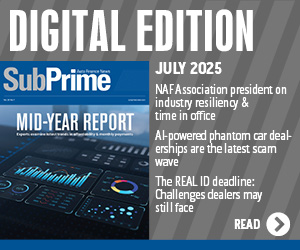Credit Acceptance Sees Decrease in Net Income Due to Change in Business
SOUTHFIELD, Mich. — Reporting its third-quarter results, Credit Acceptance indicated that its loan portfolio grew; however, increases in operating expenses and finance charges that expanded slower than loan receivables led the company to report lower income than the prior year.
For the period, the company posted net income of $14.7 million, compared with $15.3 million for the same time frame in 2006. Meanwhile, income from continuing operations came in at $13.5 million, compared with $15.4 million.
"The average size of our loan portfolio grew 27.2 percent," officials explained. "Finance charges grew by 19.5 percent. Finance charges grew slower than loans receivable as a result of pricing changes implemented during the third quarter of 2006."
The loan portfolio jump was thanks to an expanded size of the company's combined dealer and purchased loan portfolio, which was due to more active dealer partners.
"The increase was partially offset by a 230 basis point decrease in the combined average yield on dealer and purchased loans because of the pricing changes," officials pointed out.
Credit Acceptance also indicated that loan origination dollar volume was down 0.3 percent for the quarter, compared to the same period of 2006. Average volume per dealer partner was down as a result of reduced advance rates compared to the previous year.
"Advance rates were reduced during the first six months of 2007 in order to increase the spread between the advance rate and the collection rate and reduce the risk of future advance losses," executives said.
Continuing on, Credit Acceptance said operating expenses were up 18.2 percent as a result of more employees added to support growth. Executives noted that the increase in operating expenses was offset by a decrease in restricted stock compensation and bonus expense.
"We increased our use of debt through share repurchases and dealer loan and purchased loan originations," officials pointed out. "The average ratio of debt to equity for the three months increased from 1.0 to 1.9.
"Increased debt levels caused interest expense to increase $3.2 million," they added.
Executives also noted that they revamped how the company accounts for license fees as a result of a change in the methodology of collecting fees from dealer partners. The change led to lower license fees by $3.5 million.
"The provision for credit losses increased $1.5 million primarily due to increases in the provision for credit losses required to reduce the carrying value of the dealer loans to maintain the initial yield established at the inception of each dealer loan," officials said.
For the third quarter, the provision for credit losses was 2.7 percent, compared with 2.4 percent, according to the company.
As for sales and marketing, the company noted a downswing as a percentage of revenue, attributing it to a decrease in dealer-partner support products and service expenses. Basically, dealer partners used fewer of these services.
The company also posted a quarterly gain $1.3 million from its discontinued United Kingdom operations. The increase is due to an adjustment to tax reserves from the prior periods.
Discussing the nine-month time frame, officials said net income declined to $42.4 million from $50.1 million for the same period last year. The explanation for the decrease was very similar to the reasons given for the third-quarter drop in net income.
Income from continuing operations for the company was $41.3 million, compared with $50.3 million.
"The average size of our loan portfolio grew 21.7 percent," officials said. "Finance charges grew by 14.7 percent. Finance charges grew slower than loans receivable as a result of pricing changes implemented during the third quarter of 2006."
Again, the increased size of Credit Acceptance's portfolio was due to more active dealer partners, along with a jump in the average loan size. However, the increase was somewhat offset by a 190-basis-point decline in the combined yield on both dealer and purchased loans due to the pricing changes.
Operating expense was also up 14.9 percent due to the additional employees.
Moreover, executives said they increased the company's use of debt through share repurchases and dealer loan and purchased loan originations.
"The average ratio of debt to equity for the nine months increased from 0.8 to 2.0," officials reported. "Increased debt levels caused interest expense to increase $11.7 million."
The change in license fees led to a reduction in charges by $9.5 million, according to the company.
Additionally, officials said, "The provision for credit losses increased $6 million primarily due to increases in the provision for credit losses required to reduce the carrying value of the dealer loans to maintain the initial yield established at the inception of each dealer loan."
As an annualized percentage of receivables, the provision for credit losses was 2 percent for the nine-month time frame, compared with 1.4 percent for the same period last year.


